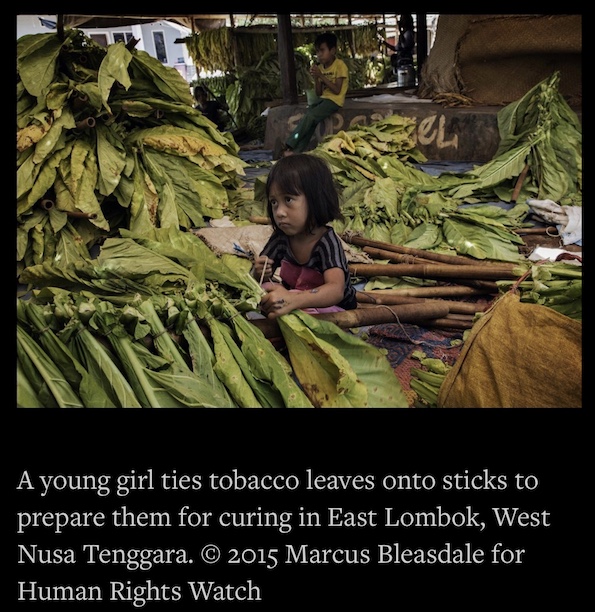Child labor in East Lombok, West Nusa Tenggara
A young girl ties tobacco leaves onto sticks to prepare them for curing in East Lombok, West Nusa Tenggara. © 2015 Marcus Bleasdale for Human Rights Watch

Of the products we use, wear, or consume every day, how many are made with child labor? Perhaps quite a few. A new report from the US Department of Labor identifies 148 different consumer goods produced with child or forced labor around the world. The list includes clothing, beef, sugar, bricks, coffee, and other products originating from 76 countries.
Gold tops the list. The report found that in at least 21 countries, children help mine gold, climbing into unstable shafts, carrying and crushing heavy loads of ore, and often using toxic mercury to process the gold. My colleagues and I have seen how dangerous this work can be, documenting the risks child miners face in Ghana, Philippines, Tanzania, and Mali.
Tobacco produced with child labor originates from at least 16 countries, placing it in the report’s top five. Child tobacco workers often labor in extreme heat, are exposed to dangerous pesticides, and risk nicotine poisoning from handling tobacco plants. In our investigations, children in the United States, Indonesia, and Zimbabwe have described nausea, vomiting, headaches, and dizziness while working in tobacco fields.
HUMAN RIGHTS WATCH
is now on Apple News
Follow on Apple News
Governments, companies, and consumers share responsibility to end child labor. Governments should monitor and enforce their labor laws and provide children with good-quality, free education.
For children old enough to work, both governments and companies should ensure their jobs do not risk anyone’s health or safety. Companies should also monitor their supply chains, report on their efforts, and when child labor is found, transition these children to school or safe alternatives. Our report on the jewelry industry outlines steps companies should take.
Consumers can ask retailers and manufacturers about their child labor policies and practices.
Ending child labor is possible. Since 2000, the number of children involved in it has dropped by a third ‒ from 245 million to 152 million. In the last two years, the Department of Labor found that 17 governments have made “significant” advancement in ending child labor, and another 60 have made “moderate” advancements. It noted particular progress in ending child labor in Panama’s sugar production, and cotton harvesting in Paraguay and Uzbekistan.
Still, we have a long way to go. Products that are part of our daily lives shouldn’t come at the expense of children’s health, safety, and education.
| Attachment | Size |
|---|---|
| Tobaccco1.jpg | 175.56 KB |
- Editor1's blog
- Login to post comments